MK-1775
- CAS NO.:955365-80-7
- Empirical Formula: C27H32N8O2
- Molecular Weight: 500.6
- MDL number: MFCD17215200
- SAFETY DATA SHEET (SDS)
- Update Date: 2025-08-06 15:14:14
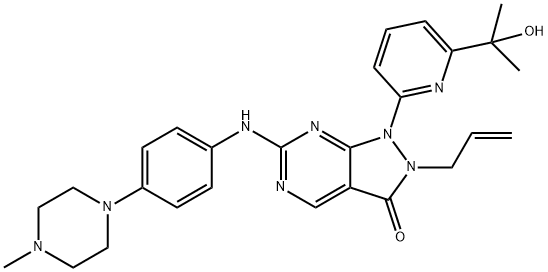
What is MK-1775?
Description
MK-1775 is a small molecule inhibitor of the tyrosine kinase WEE1 with potential antineoplastic sensitizing activity. MK-1775 selectively targets and inhibits WEE1, a tyrosine kinase that phosphorylates cyclin-dependent kinase 1 (CDK1, CDC2) to inactivate the CDC2/cyclin B complex. Inhibition of WEE1 activity prevents the phosphorylation of CDC2 and impairs the G2 DNA damage checkpoint. This may lead to apoptosis upon treatment with DNA damaging chemotherapeutic agents. MK-1775 is a type of biological therapy. It is a cancer growth blocker. It stops signals that cancer cells use to divide and grow. MK-1775 has been used in trials studying the treatment of LYMPHOMA, Neoplasms, Ovarian Cancer, Tongue Carcinoma, and Adult Glioblastoma, among others.
The Uses of MK-1775
MK 1775 is used in biological studies for the abrogation of G2/M checkpoint through WEE1 inhibition in combination with chemotherapy as a promising therapeutic approach for mesothelioma.
Definition
ChEBI: 1-[6-(2-hydroxypropan-2-yl)-2-pyridinyl]-6-[4-(4-methyl-1-piperazinyl)anilino]-2-prop-2-enyl-3-pyrazolo[3,4-d]pyrimidinone is a member of piperazines.
Clinical Use
MK-1775 is a novel, potent and selective Wee1 kinase inhibitor used in clinical studies for the treatment of a variety of solid tumours (including lymphoma, multiple myeloma, oropharyngeal, cervical, vaginal and ovarian cancers). Nanomolar concentrations of MK-1775 radiosensitised p53-deficient human lung, breast and prostate cancer cells, but did not radiosensitise similar cell lines with wild-type p53. Consistent with the radiosensitising ability, MK-1775 attenuated radiation-induced G2 block in p53-deficient cells, whereas p53 wild-type cell lines did not. MK-1775 also significantly enhanced the anti-tumour efficacy of radiation in vivo in tumour growth delay studies, which also applied to p53-deficient tumours.
Side Effects
Common side effects of Adavosertib (MK-1775) when used alone or in combination with other chemotherapy drugs include: nausea, vomiting, anaemia, diarrhoea, loss of appetite, decreased white blood cell count, decreased platelet count, and fever. Other side effects that may occur are: constipation, rectal pain, anaemia, diarrhoea. Severe febrile neutropenia, hypophosphatemia, acute respiratory distress syndrome and interstitial pneumonia can result. Contact your doctor if any of these serious adverse reactions occur.
in vitro
mk-1775 dose-dependently inhibited phosphorylation of cdc2 at tyr15 and abrogated the g2dna damage checkpoint. mk-1775 inhibited wee1 kinase in an atp-competitive manner with an ic50 value of 5.2 nmol/l in the in vitro kinase assays. compared to wee1, mk-1775 displayed 2- to 3-fold less potency against yes with the ic50value of 14 nm, 10-fold less potency against seven other kinases with >80% inhibition at 1 μm, and >100-fold selectivity over human myt 1, another kinase that inhibited cyclin-dependent kinase 1 (cdc2) by phosphorylation at an alternative site (thr14). by abrogating the dna damage checkpoint via blockade of wee1 activity in widr cells bearing mutated p53, mk-1775 treatment inhibited the basal phosphorylation of cdc2 at tyr15 (cdc2y15) with an ec50 of 49 nm, and dose-dependently suppressed gemcitabine-, carboplatin- or cisplatin-induced phosphorylation of cdc2 and cell cycle arrest, with the ec50 of 82 nm and 81 nm, 180 nm and 163 nm, as well as 159 nm and 160 nm, respectively. in widr and h1299 cells, mk-1775 treatment (30-100 nm)showed no significant antiproliferative effects, whereas mk-1775 at 300 nm was sufficient to inhibit wee1 by >80%, displayed moderate but significant antiproliferative effects by 34.1% in widr cells and 28.4% in h1299 cells [1].
Storage
Store at -20°C
References
Hirai et al. (2009) Small-molecule inhibition of Wee1 kinase by MK-1775 selectively sensitizes p53-deficient tumor cells to DNA-damaging agents; Cancer Ther.?8 2992 Pan et al. (2021) A novel WEE1 pathway for replication stress responses; Plants 7 209 Guo et al. (2022) WEE1 inhibition induces anti-tumor immunity by activating ERV and the dsRNA pathway; Exp. Med. 219 e20210789 Seo et al. (2021) Inhibition of WEE1 Potentiates Sensitivity to PARP Inhibitor in Biliary Tract Cancer; Cancer Res. Treat. Epub ahead of print
Properties of MK-1775
| Melting point: | 179-181°C |
| Boiling point: | 723.8±70.0 °C(Predicted) |
| Density | 1.292 |
| storage temp. | -20°C |
| solubility | Soluble in DMSO (70 mg/ml) |
| form | solid |
| pka | 13.27±0.29(Predicted) |
| color | Yellow |
| Stability: | Stable for 2 years from date of purchase as supplied. Solutions in DMSO may be stored at -20°C for up to 3 months. |
Safety information for MK-1775
| Signal word | Warning |
| Pictogram(s) |
 Exclamation Mark Irritant GHS07 |
| GHS Hazard Statements |
H302:Acute toxicity,oral |
| Precautionary Statement Codes |
P280:Wear protective gloves/protective clothing/eye protection/face protection. P305+P351+P338:IF IN EYES: Rinse cautiously with water for several minutes. Remove contact lenses, if present and easy to do. Continuerinsing. |
Computed Descriptors for MK-1775
| InChIKey | BKWJAKQVGHWELA-UHFFFAOYSA-N |
| SMILES | C1(NC2=CC=C(N3CCN(C)CC3)C=C2)=NC=C2C(=O)N(CC=C)N(C3=NC(C(O)(C)C)=CC=C3)C2=N1 |
New Products
4,4-Difluoropiperidine hydrochloride tert-butyl 9-methoxy-3-azaspiro[5.5]undecane-3-carboxylate Indole Methyl Resin N-Isopropylurea N,N-Dicyclohexylcarbodiimide(DCC) MELDRUMS ACID 5-METHYLISOXAZOLE-4-CARBOXYLIC ACID Magnessium Bis glycinate Zinc ascorbate 1-bromo-2-butyne 2-acetamidophenol 9(10H)-anthracenone Erythrosin B, 4-Piperidinopiperidine 2-((4-morpholinophenylamino) (methylthio) methylene) malononitrile 2,4-dihydroxybenzaldehyde 3-(4-morpholinophenylamino)-5-amino-1H-pyrazole-4-carbonitrile Methyl 2-methylquinoline-6-carboxylate 2,6-dichloro-4-nitropyridine 4-Bromo-2-chlorobenzonitrile 2-(benzylamino)acetic acid hydrochloride 4-(tert-Butoxycarbonylamino)but- 2-ynoic acid 3,4-dihydro-2H-benzo[b][1,4]dioxepine 1-Phenyl-1-cycloprppanecarboxylicacidRelated products of tetrahydrofuran
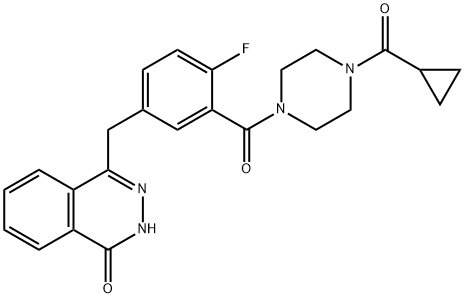
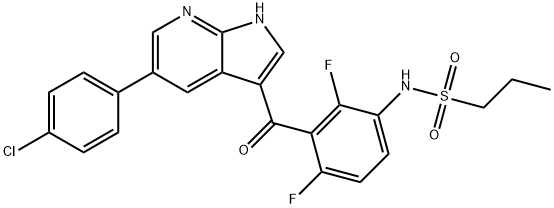
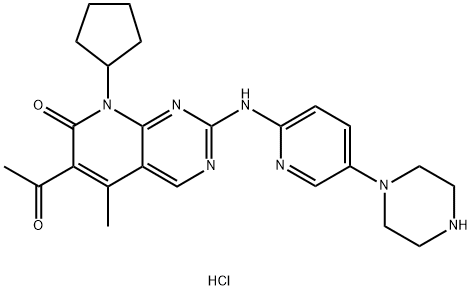
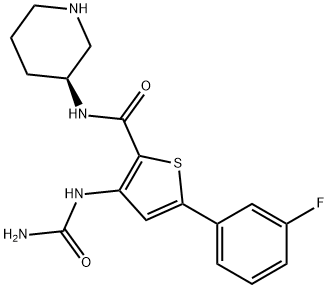
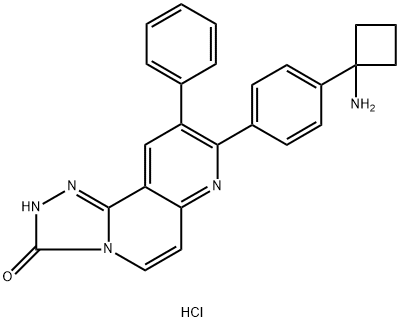
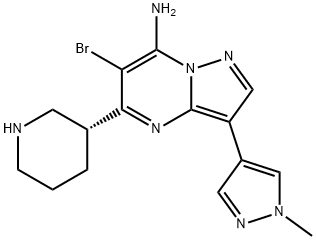
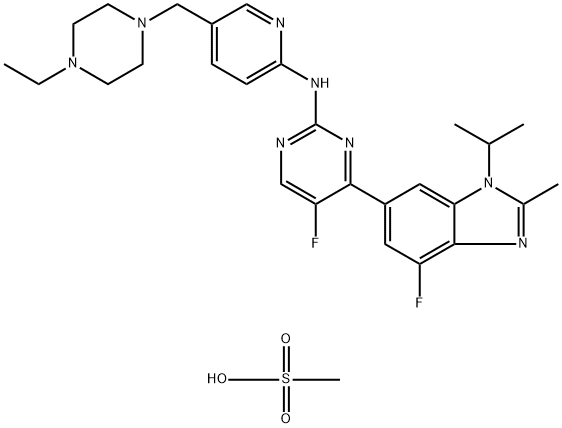
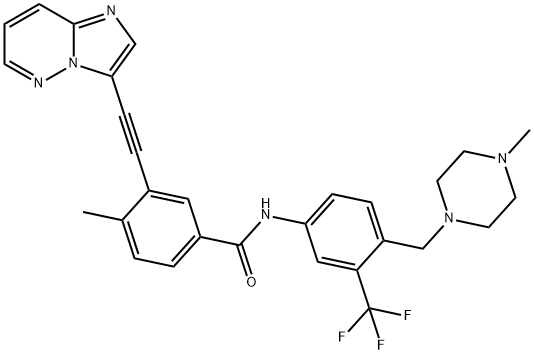
You may like
-
 MK-1775 >95% CAS 955365-80-7View Details
MK-1775 >95% CAS 955365-80-7View Details
955365-80-7 -
 3-(4-amino-1-oxoisoindolin-2-yl)-1-methylpiperidine-2,6-dione 98%View Details
3-(4-amino-1-oxoisoindolin-2-yl)-1-methylpiperidine-2,6-dione 98%View Details -
 614-19-7 98%View Details
614-19-7 98%View Details
614-19-7 -
 3112-85-4 Methyl phenyl sulfone 98%View Details
3112-85-4 Methyl phenyl sulfone 98%View Details
3112-85-4 -
 20677-73-0 (2,2-diethoxyethyl)methylamine 98%View Details
20677-73-0 (2,2-diethoxyethyl)methylamine 98%View Details
20677-73-0 -
 3-(4-(hydroxyamino)-1-oxoisoindolin-2-yl)piperidine-2,6-dione 98%View Details
3-(4-(hydroxyamino)-1-oxoisoindolin-2-yl)piperidine-2,6-dione 98%View Details -
 57381-49-4 2-bromo-4-chlorobenzonitrile 98%View Details
57381-49-4 2-bromo-4-chlorobenzonitrile 98%View Details
57381-49-4 -
 4,6-dichloropyrimidine-5-carbaldehyde 98%View Details
4,6-dichloropyrimidine-5-carbaldehyde 98%View Details
5305-40-8
